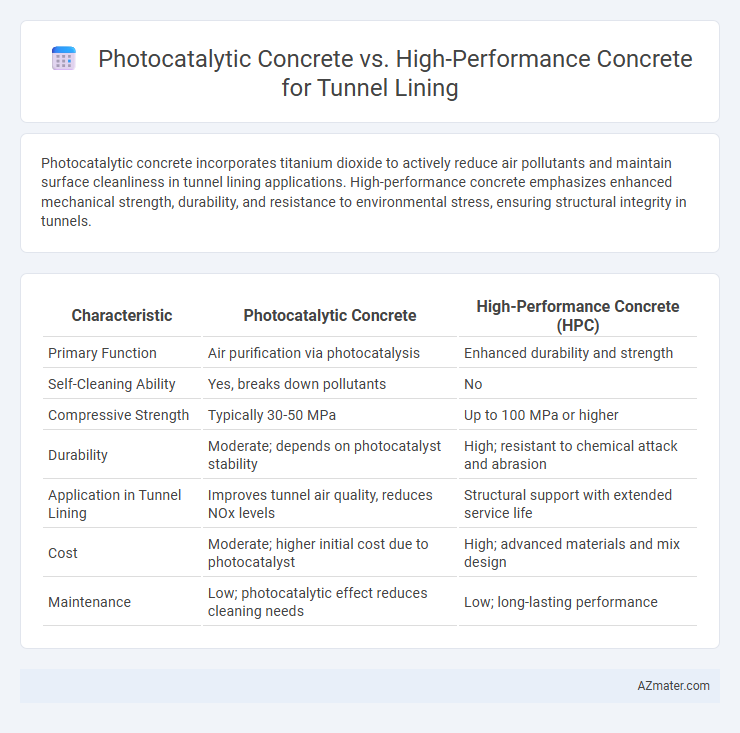Photocatalytic concrete incorporates titanium dioxide to actively reduce air pollutants and maintain surface cleanliness in tunnel lining applications. High-performance concrete emphasizes enhanced mechanical strength, durability, and resistance to environmental stress, ensuring structural integrity in tunnels.
Table of Comparison
| Characteristic | Photocatalytic Concrete | High-Performance Concrete (HPC) |
|---|---|---|
| Primary Function | Air purification via photocatalysis | Enhanced durability and strength |
| Self-Cleaning Ability | Yes, breaks down pollutants | No |
| Compressive Strength | Typically 30-50 MPa | Up to 100 MPa or higher |
| Durability | Moderate; depends on photocatalyst stability | High; resistant to chemical attack and abrasion |
| Application in Tunnel Lining | Improves tunnel air quality, reduces NOx levels | Structural support with extended service life |
| Cost | Moderate; higher initial cost due to photocatalyst | High; advanced materials and mix design |
| Maintenance | Low; photocatalytic effect reduces cleaning needs | Low; long-lasting performance |
Introduction to Modern Tunnel Lining Materials
Photocatalytic concrete incorporates titanium dioxide to actively reduce air pollutants through photocatalysis, enhancing air quality within tunnels. High-performance concrete features superior strength, durability, and resistance to environmental stressors, ensuring long-term structural integrity for tunnel linings. Modern tunnel lining materials prioritize both environmental sustainability and mechanical performance to optimize safety and maintenance costs.
Overview of Photocatalytic Concrete Technology
Photocatalytic concrete integrates titanium dioxide (TiO2) nanoparticles that activate under UV light to break down pollutants and organic matter on tunnel surfaces, enhancing air quality and reducing maintenance costs. This technology leverages the photocatalytic reaction to provide self-cleaning properties and improve durability compared to traditional high-performance concrete formulations. Its application in tunnel lining offers environmental benefits by mitigating nitrogen oxides (NOx) and particulate matter, contributing to sustainable infrastructure development.
Key Features of High-Performance Concrete
High-performance concrete (HPC) used in tunnel lining offers superior compressive strength, enhanced durability, and increased resistance to chemical attacks and freeze-thaw cycles compared to photocatalytic concrete. HPC features optimized particle packing, low permeability, and controlled water-to-cement ratios, making it ideal for withstanding harsh underground environments and heavy structural loads. While photocatalytic concrete provides self-cleaning and pollution-reducing benefits, HPC's mechanical robustness and longevity remain critical for tunnel infrastructure safety and stability.
Comparative Strength and Durability
Photocatalytic concrete incorporates titanium dioxide, enabling self-cleaning and pollution-reducing properties while maintaining compressive strengths typically ranging from 30 to 50 MPa, suitable for tunnel linings exposed to harsh environments. High-performance concrete (HPC) achieves superior strength exceeding 60 MPa through optimized mix designs, often including silica fume and superplasticizers, offering enhanced durability against chloride ingress and freeze-thaw cycles critical for long-term tunnel stability. Comparative durability studies indicate HPC provides greater resistance to mechanical wear and chemical attack, whereas photocatalytic concrete offers added environmental benefits without compromising essential structural integrity.
Environmental Benefits and Air Purification
Photocatalytic concrete incorporates titanium dioxide, enabling it to break down pollutants such as nitrogen oxides and volatile organic compounds, significantly improving air quality in tunnel environments. High-performance concrete, while offering enhanced durability and strength, lacks the inherent air-purifying properties found in photocatalytic variants. The adoption of photocatalytic concrete in tunnel lining contributes to environmental benefits by reducing harmful emissions and promoting cleaner indoor air, making it a sustainable choice for urban infrastructure.
Maintenance Requirements and Longevity
Photocatalytic concrete for tunnel lining offers self-cleaning properties due to titanium dioxide additives, significantly reducing maintenance by breaking down pollutants and preventing surface degradation. High-performance concrete (HPC) provides superior mechanical strength and durability, enhancing structural longevity and resisting chemical attacks, but may require routine inspections and maintenance to manage cracking and water ingress over time. Choosing photocatalytic concrete can lower cleaning and repair frequency, whereas HPC ensures long-term structural integrity under extreme load conditions.
Cost Analysis and Economic Considerations
Photocatalytic concrete, incorporating titanium dioxide, provides enhanced air-purifying benefits and reduced maintenance costs in tunnel lining applications compared to high-performance concrete (HPC), but generally incurs higher initial material expenses. HPC offers superior mechanical strength and durability, leading to extended service life and lower repair costs, making it economically favorable for load-bearing structures despite higher upfront production costs. Cost analysis must account for long-term factors such as reduced environmental remediation and maintenance frequency with photocatalytic concrete versus the proven structural economy of HPC in tunnel infrastructure.
Construction Challenges and Solutions
Photocatalytic concrete for tunnel lining faces construction challenges such as slower curing times and sensitivity to environmental conditions, requiring precise moisture and temperature control during application. High-performance concrete offers superior strength and durability but demands advanced mixing and placement techniques to prevent shrinkage and cracking in confined tunnel environments. Solutions include using controlled curing chambers for photocatalytic layers and implementing fiber reinforcement and optimized admixtures in high-performance mixes to enhance mechanical properties and mitigate construction risks.
Case Studies and Real-world Applications
Photocatalytic concrete, utilized in tunnel linings, has demonstrated significant air-purifying capabilities by decomposing pollutants like NOx, as evidenced in the Lingang Tunnel in Shanghai, where it contributed to enhanced air quality. High-performance concrete (HPC), noted for its superior durability, strength, and resistance to chemical attack, has been successfully applied in tunnel projects such as the Gotthard Base Tunnel in Switzerland, ensuring structural integrity under extreme conditions. Comparative case studies reveal that while HPC offers unparalleled mechanical reliability, photocatalytic concrete provides added environmental benefits, making it suitable for urban tunnels prioritizing pollution reduction.
Future Trends in Tunnel Lining Materials
Photocatalytic concrete integrates titanium dioxide to actively reduce pollutants and enhance air quality in tunnel environments, positioning it as a sustainable choice for future tunnel lining materials. High-performance concrete (HPC) offers superior mechanical strength, durability, and resistance to chemical attack, making it essential for tunnels subjected to extreme loads and harsh conditions. Emerging trends emphasize combining photocatalytic properties with HPC formulations to develop multifunctional tunnel linings that improve structural longevity while minimizing environmental impact.

Infographic: Photocatalytic concrete vs High-performance concrete for Tunnel lining
 azmater.com
azmater.com